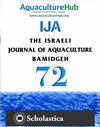IF 0.5
4区 农林科学
Q4 FISHERIES
引用次数: 1
摘要
采用16S rRNA扩增子测序方法分析了凡纳滨对虾(Litopenaeus vannamei)在单养殖和与卵形沙盘虫(Trachinotus ovatus)混合养殖中肠道、养殖水体和沉积物中的微生物群落结构。从21份样本中获得1,120,500个有效reads,分类出3,767个操作分类单位(operational taxonomic units, otu)。在两种培养模式下,沉积物中细菌的丰度和多样性均显著高于单一培养模式下的凡纳梅螺旋藻肠道、混合培养模式下凡纳梅螺旋藻和卵形螺旋藻水体和肠道中细菌的丰度和多样性(P < 0.05)。单作模式下,凡纳梅乳杆菌与卵形乳杆菌肠道菌群结构差异不显著(P > 0.05)。两种培养模式下沉积物的优势门为变形菌门、拟杆菌门和绿菌门。在两种培养模式下,水和凡纳梅乳杆菌肠道内的微生物群落结构相似。优势门为蓝藻门、变形菌门和放线菌门,丰度在80.88% ~ 97.10%之间。变形菌门为各组样品的优势门,两种培养模式下的优势属均为GpIIa。两种培养方式下微生物群落结构差异不大;虽然培养方式对核心门/属没有影响,但相对丰度存在差异。实验结果为探索高效、特异的益生菌筛选和微生物配方技术提供了参考。本文章由计算机程序翻译,如有差异,请以英文原文为准。
Microbiota in monocultured Litopenaeus vannamei vs. polyculture with Trachinotus ovatus
The structures of the microbial community in the intestine, aquaculture water, and sediment of Litopenaeus vannamei, both in monoculture and mixed culture with Trachinotus ovatus, were analyzed by sequencing 16S rRNA amplicons. 1,120,500 valid reads were obtained from 21 samples, and 3,767 operational taxonomic units (OTUs) were classified. In the two culture modes, the abundance and diversity of bacterial in the sediment were significantly higher than in the L. vannamei intestine under the monoculture mode, in the water and intestines of L. vannamei and T. ovatus under the mix-culture mode (P < 0.05). There was no significant difference between the intestinal flora structures of L. vannamei and T. ovatus in the monoculture mode (P > 0.05). The dominant phyla in the sediment under two culture modes were Proteobacteria, Bacteroidetes, and Chloroflexi. The microbial community structure in the water and L. vannamei intestine were similar in both culture modes. The dominant phyla included Cyanobacteria, Proteobacteria, and Actinobacteria, with their abundances ranging from 80.88% to 97.10%. Proteobacteria was the dominant phylum in each group of samples, and the dominant genus in both culture modes was GpIIa. There was little difference in microbial community structures under the two culture modes; while the culture mode did not affect the core phyla/genera, there were differences in relative abundance. The experimental results provide a reference for the exploration of efficient and specific probiotic screening and microbial formulation techniques.
求助全文
通过发布文献求助,成功后即可免费获取论文全文。
去求助
来源期刊
CiteScore
0.90
自引率
16.70%
发文量
49
审稿时长
3 months
期刊介绍:
Information not localized

 求助内容:
求助内容: 应助结果提醒方式:
应助结果提醒方式:


